HOME
Polish Origins back to 10th Century
Ancestry.com
In the area that is today called Poland, in the early centuries AD there
lived many groups or tribes, including the Celts, Balts, Scythians,
Huns, Goths, and Germanic peoples. It is believed that the Slavs
arrived in the 6th or 7th century when several differnt Slavic tribes
settled in the area.
By the mid-10th century, the Polania tribe became
dominant.
Legends say that the chief, Piast, united the groups into one
cohesive unit, naming it Polska (Poland)This region became Wielkopolska, or Greater Poland.
966
Duke Mieszko I, Poland's first recorded leader, converted to
Christianity after marrying Dabrowka of Bohemia. This is formally
recognized as the birth of the Polish nation.
By accepting Christianity, Poland became an influential participant
in the sphere of Western culture. Poznan became the Episcopal see, or
capital city. Mieszko allied himself with the German Emperor Otto I and
placed his land under the protection of the pope.
966 - 1370 The Piast Dynasty
992
Duke Mieszko I dies. By the time of his death, Poland's borders
extended to an area similar to today's boundaries. The city of Gniezno
was the capital, and the towns of Gdansk, Szczecin, Poznan, Wroclaw, and
Krakow already exist.
1100s
Boleslaw Krzywousty (Boleslaus the Wry-Mouthed) divides Poland
among his sons in an apparent attempt to reinforce unity. The division
instead caused rivalry, leaving Poland prey to various foreign invaders.
1295
 White Eagle from majestatic seal of
Przemysł II from 1295
White Eagle from majestatic seal of
Przemysł II from 1295
1320
Polish state is reunified.
1333 - 1370
Poland achieves political and cultural unity under the rule of
Kazimierz III Wielki (Casimir the Great). The city of Krakow
flourishes as capital.
1364
The university is founded at Krakow, one of Europe's first universities.
382-1572
The Jagiellonian Dynasty
1
1382
The Polish crown is passed on to 10-year old Jadwiga. Poland
forms an alliance with the pagan Lithuania when young Jadwiga marries
Duke Jagiello of Lithuania. Jagiello converts to Christianity and
becomes Wladyslaw II Jagiello, ruling from 1386-1434. The union
increases Poland's boundaries dramatically and creates an alliance with
Lithuania that lasts for 400 years.
During this time there are many wars against various enemies
(Teutonic Knights, Tatars, Russia, the Ottoman Empire). However, the
country prospers economically, culturally, and spiritually.
1500s
The Renaissance comes to Poland. Polish becomes the language in lieu of
Latin. Literature, learning, culture, and architecture flourish.
1543
Nicolaus Copernicus (Mikolaj Kopernik) publishes "On the
Revolutions of the Celestial Spheres," proposing that the earth revolves
around the sun.
1569
The Polish Parliament, or Sejm, unifies Poland and Lithuania into one
state. Royal succession is now based on election by the Sejm, including
allowing foreign candidates for consideration. The decision was
disastrous for Poland, and during the period of the Royal Republic, only
four out of eleven kings were native Poles.
1572-1795 The Royal Republic
1573
The Sejm guarantees religious equality. Roman Catholics, Jews,
Protestants, Orthodox Christians, and Muslims all live together in
Poland in peace.
1596-1609
Poland's capital city is moved from
Krakow to
Warsaw.
1597
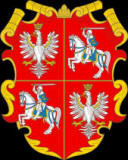 Grand
coat of arms of the Polish-Lithuanian Commonwealth 1597
Grand
coat of arms of the Polish-Lithuanian Commonwealth 1597
1655-60
Known as the Deluge, Sweden invades Poland with the help of the Tartars
and Cossacks from the East. Poland is virtually destoyed as cities are
burned and plundered. A population of 10 million is reduced to 6
million due to the wars, famine, and the bubonic plauge.
1674-96
This period is the reign of Jan III Sobieski, an excellent
military commander. Sobieski's forces have many victories over the
Turks.
1700s
Poland's three powerful neighbors, Russia, Prussia and Austria, each
want to own Poland. This was all but impossible without risking war
with each other. They finally settled their dispute by dividing Poland
among themselves in a series of agreements called the Three Partitions
of Poland.
1791
After the First Partition leads to some reforms, a constitution is
passed, called the
Constitution of the Third of May. It is the second written
document that outlines the responsibilities of the Government (the U.S.
Constitution is the first). Catherine the Great of Russia invades
Poland to break up the newfound democracy.
1793
During the Second Partition, Russia and Prussia take over half of what
was left of Poland.
1794
Tadeusz Kosciuszko, the famous general who helped win the
American Revolution, starts a rebellion for Polish independence, but it
is not strong enough to defeat the Russians.
1795
The Third Partition divides the rest of Poland. Poland is "officially"
non-existent for the next 123 years.
1863
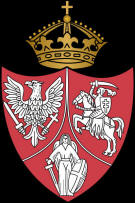 Coat
of arms January Uprising 1863
Coat
of arms January Uprising 1863
1870s
Russia attempts to eradicate Polish culture, making Russian the official
language of the Russian partition. Prussia does the same in their
portion of Poland, attempting to Germanicize Poles. Under the Austrian
partition, Galician Poles are allowed to retain some autonomy.
1890s
Poland experiences mass emigration due to poverty. Approximately 4
million out of 22 million Poles emigrate to the United States prior to
World War I.
914-18 World War I - 1
With Poland's three occupying powers at war with each other, Poland
becomes the main fighting ground. Because there was no official Polish
state, there was no Polish army. Poles were forced into the Russian,
German, and Austrian armies and forced to fight against one another.
Native Poles now in America join
Haller's Army
in France to fight for their country.
11 November 1918
Poland becomes independent as WWI comes to an end. The country was
devastated by the war. Approximately one million Poles died. All
Polish institutions had to be rebuilt as the country once again formed a
nation. The official boundaries are not set until 1923.
Coat of arms of the
Kingdom of Poland (1916–1918)
1919
The Treaty of Versailles gives Poland western Prussia, thus
getting access to the Baltic Sea.
1919-20
During the Polish-Soviet War, Jozef Pilsudski's army defeats the
Russians. Poland gains western Ukraine and Belarus.
1919
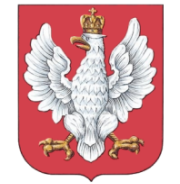 Coat of arms of the
Second Polish Republic (1919-1927)
Coat of arms of the
Second Polish Republic (1919-1927)
1926
Pilsudski makes himself dictator of Poland. Despite the dictatorship,
the economy stabilized at this time and culture continued to prosper.
1927
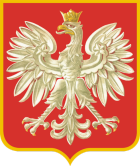 Coat of arms of the
Second Polish Republic
Coat of arms of the
Second Polish Republic
1930s
Poland signs nonagression pacts with Germany and the Soviet Union. The
pacts soon prove to be pointless.
23 August 1939
Germany and the Soviet Union sign a nonagression pact, with Stalin and
Hitler planning to divide Poland once again.
1939-45 World War II
1939
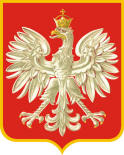 Polish Government in Exile (1939-1990) Coat of arms with the cross
atop the crown
Polish Government in Exile (1939-1990) Coat of arms with the cross
atop the crown
September 1939
Hitler invades
Poland on 01 September. On 17 September, the Soviet Union
invades eastern Poland. Mass arrests, executions, and exiles begin.
June 1941
Hitler attacks the Soviet Union, and Poland remains under the Nazi
regime for the next three years. Many Poles are deported to labor
camps. The Polish intelligentsia are executed, and the Nazis plan to
elimate the Polish Jews entirely. Most of Poland's Jewish population,
including many non-Jews, die in Nazi death camps set up throughout
Poland at Maidanek, Birkenau, and Oswiecim (Auschwitz). The Germans
exterminated most of Poland's three million Jews, along with Jews from
other occupied countries.
April 1943
The
Warsaw Ghetto Uprising is the single largest act of defiance,
and the most tragically unsuccessful.
1945
 People's Republic of Poland (1945-1989) Coat of arms without the
crown.
People's Republic of Poland (1945-1989) Coat of arms without the
crown.
1944 -
In 1944, the Warsaw Uprising
took place. Russia's Red Army is victorious over the Germans. Russia
set up a Communist-dominated government for Poland in Lublin. In
February 1945, Russia, United States, and Great Britian meet at the
Yalta Conference and agree to leave Poland under Soviet
control.
At the war's end, over 6 million Poles were dead, approximately 20%
of Poland's pre-war population.
1956
Industrial strikes break out in Poznan in an attempt to gain "bread and
freedom" from Soviet rule. In October a reformed government is elected
without the stamp of Moscow approval. This unheard of defiance elicits
a visit from Khrushchev and results in several armies massing at the
Polish border.
1956 - 1970s
Poland experiences some internal independence under Soviet rule, most
importantly the Church survives and even flourishes as a counterpoint to
Soviet repression. Poland manages to rebuild its war-devastated iron,
steel, shipping, and mining industries, buy fails to regain a decent
standard of living.
1978
Karol Wojtyla,
the Archbishop of Krakow, is elected Pope. Taking the name John Paul
II, he is the first non-Italian pope in nearly 500 years.
1980
Strikes and riots ensue as the economy crumbles. At the Lenin Shipyard
in Gdansk, the
government reaches an agreement with the workers. The workers are
allowed to organize into an independent trade union, called Solidarnosc,
or Solidarity. Strike leader
Lech Walesa is elected as the head of Solidarity, and by
November 60% of the Polish workforce is organized. Solidarity gradually
grows into a srong, non-violent, sociopolitical movement.
1981
In December, Martial Law is declared. Solidarity is suspended.
1982
The government formally dissolves Solidarity. The cost of living rises
over 100% during the year.
1983
Martial law is lifted.
1989
In April, Solidarity is re-established.
1990
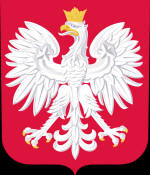 Republic of Poland (1990-current) Crown restored.
Republic of Poland (1990-current) Crown restored.
Prices rise by 250%, with incomes dropping by 40%. In November, the
first fully free election is won by Lech Walesa. His rule results in
disillusionment as no economic miracles take place, and the political
forces fail to stabilize.
1997
Poland's National Assembly adopts a new
Constitution.
Today Poland continues to gain international credibility and is a
member of NATO.
Polish History Links
Compiled by Donna Pointkouski and Ed
Wojtowicz
 White Eagle from majestatic seal of
White Eagle from majestatic seal of
 Grand
Grand
 Coat
of arms January Uprising 1863
Coat
of arms January Uprising 1863


